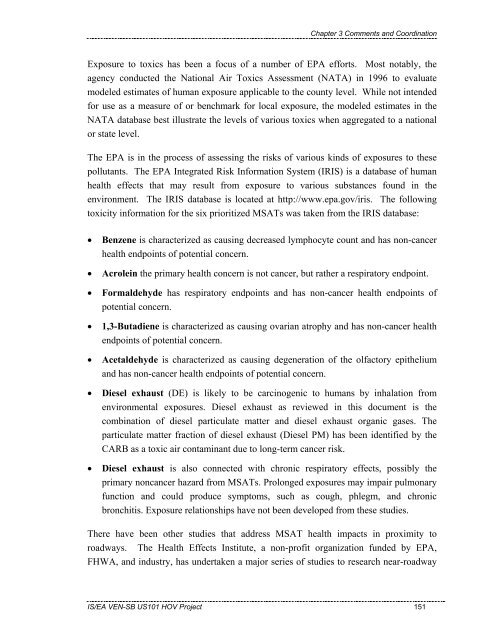Chapter 1 - Caltrans - State of California
Chapter 1 - Caltrans - State of California
Chapter 1 - Caltrans - State of California
You also want an ePaper? Increase the reach of your titles
YUMPU automatically turns print PDFs into web optimized ePapers that Google loves.
<strong>Chapter</strong> 3 Comments and Coordination<br />
Exposure to toxics has been a focus <strong>of</strong> a number <strong>of</strong> EPA efforts. Most notably, the<br />
agency conducted the National Air Toxics Assessment (NATA) in 1996 to evaluate<br />
modeled estimates <strong>of</strong> human exposure applicable to the county level. While not intended<br />
for use as a measure <strong>of</strong> or benchmark for local exposure, the modeled estimates in the<br />
NATA database best illustrate the levels <strong>of</strong> various toxics when aggregated to a national<br />
or state level.<br />
The EPA is in the process <strong>of</strong> assessing the risks <strong>of</strong> various kinds <strong>of</strong> exposures to these<br />
pollutants. The EPA Integrated Risk Information System (IRIS) is a database <strong>of</strong> human<br />
health effects that may result from exposure to various substances found in the<br />
environment. The IRIS database is located at http://www.epa.gov/iris. The following<br />
toxicity information for the six prioritized MSATs was taken from the IRIS database:<br />
• Benzene is characterized as causing decreased lymphocyte count and has non-cancer<br />
health endpoints <strong>of</strong> potential concern.<br />
• Acrolein the primary health concern is not cancer, but rather a respiratory endpoint.<br />
• Formaldehyde has respiratory endpoints and has non-cancer health endpoints <strong>of</strong><br />
potential concern.<br />
• 1,3-Butadiene is characterized as causing ovarian atrophy and has non-cancer health<br />
endpoints <strong>of</strong> potential concern.<br />
• Acetaldehyde is characterized as causing degeneration <strong>of</strong> the olfactory epithelium<br />
and has non-cancer health endpoints <strong>of</strong> potential concern.<br />
• Diesel exhaust (DE) is likely to be carcinogenic to humans by inhalation from<br />
environmental exposures. Diesel exhaust as reviewed in this document is the<br />
combination <strong>of</strong> diesel particulate matter and diesel exhaust organic gases. The<br />
particulate matter fraction <strong>of</strong> diesel exhaust (Diesel PM) has been identified by the<br />
CARB as a toxic air contaminant due to long-term cancer risk.<br />
• Diesel exhaust is also connected with chronic respiratory effects, possibly the<br />
primary noncancer hazard from MSATs. Prolonged exposures may impair pulmonary<br />
function and could produce symptoms, such as cough, phlegm, and chronic<br />
bronchitis. Exposure relationships have not been developed from these studies.<br />
There have been other studies that address MSAT health impacts in proximity to<br />
roadways. The Health Effects Institute, a non-pr<strong>of</strong>it organization funded by EPA,<br />
FHWA, and industry, has undertaken a major series <strong>of</strong> studies to research near-roadway<br />
IS/EA VEN-SB US101 HOV Project 151

















